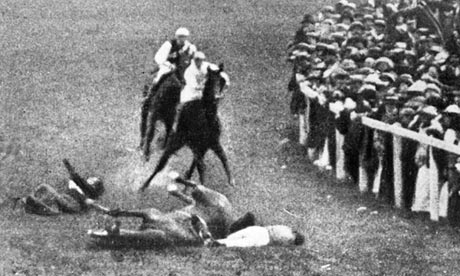 Earlier Life
Earlier Life
Emily Wilding Davison was the daughter of Charles Davison (1822–1893) and Margaret Caisley Davison (1848–1918), and was born at at Roxburgh House, Vanbrugh Park Road, Greenwich on 11th October, 1872 (Simkin, 1997). She was educated to first-class honours standard at Royal Holloway College and Oxford Universities, though as graduation was not open to women at the time was unable to claim her degree (BBC, 2014).
Emily and WSPU
Emily joined the Women's Social and Political Union in 1906 becoming an active campaigner, and three years later gave up her teaching job in order to devote herslf to the campaign full-time. Having already been arrested a number of occasions, in 1909 she earned herself a month in Manchester's Strangeways Prison after throwing rocks at the then chancellor, David Lloyd-George's carriage(BBC, 2014). She found herself one of the many campaigners who suffered the indignity of being force-fed. In protest at this treatment she barricaded herself in her cell, only being removed when authorities aimed a fire-hose at her and broke down her cell door - something she later successfully claimed damages of forty shillings for. On another occasion she threw herself over the prison staircase, though to no avail as having suffered only minor injuries was still judged fit enough to endure another bout of force-feeding with the dreaded nasal tube (Turner, 2003).
During the 1911 census boycott Emily protested by hiding herself in a cupboard in the House of Commons crypt, forcing officials to record this as her home. Today a plaque in the chapel of St. Mary Undercroft erected personally by the late Tony Benn MP commemorates this act(UK Parliament, 2014).
Emily and the Kings Horse
 Unfortunately Emily Davison's most famous act was also to prove her last. On 4 June 1913 she stepped out and grabbed the reins of Anmer, the king's horse, at the Epsom Derby. Having sustained heavy injuries she died four days later in hospital and in doing so became a martyr to the cause of women's suffrage. Her funeral was attended by over 6,000 women bearing banners and wearing the WSPU colours protesting for women's suffrage (Greer, 2013). It is still a point of debate for historians whether she deliberatley sacrificed herself for the cause, but this seem unlikely as she was found to have a return train ticket and Summer fair ticket for use later that same day and had been due to go on holiday with her sister soon after... She was also found to have writing paper, pen and stamps in her possession, common tools of the trade for an intrepid campaigner fearing arrest. It has been suggested that her true intention was to attach a flag to the horse and there can be no doubt this would have been a highly effective publicity stunt (BBC, 2013).
Unfortunately Emily Davison's most famous act was also to prove her last. On 4 June 1913 she stepped out and grabbed the reins of Anmer, the king's horse, at the Epsom Derby. Having sustained heavy injuries she died four days later in hospital and in doing so became a martyr to the cause of women's suffrage. Her funeral was attended by over 6,000 women bearing banners and wearing the WSPU colours protesting for women's suffrage (Greer, 2013). It is still a point of debate for historians whether she deliberatley sacrificed herself for the cause, but this seem unlikely as she was found to have a return train ticket and Summer fair ticket for use later that same day and had been due to go on holiday with her sister soon after... She was also found to have writing paper, pen and stamps in her possession, common tools of the trade for an intrepid campaigner fearing arrest. It has been suggested that her true intention was to attach a flag to the horse and there can be no doubt this would have been a highly effective publicity stunt (BBC, 2013). While Davison's actions were saluted by many others sent her hatemail and branded her an anarchist even as she lay dying. Perhaps surprisingly, Herbert Jones, Anmer's jockey on that fateful day afterwards said he was "haunted by that poor woman's face" and at the funeral of WSPU leader Emmeline Pankhurst in 1928 laid a wreath "to do honour to the memory of Mrs Pankhurst and Miss Emily Davison".
No comments:
Post a Comment